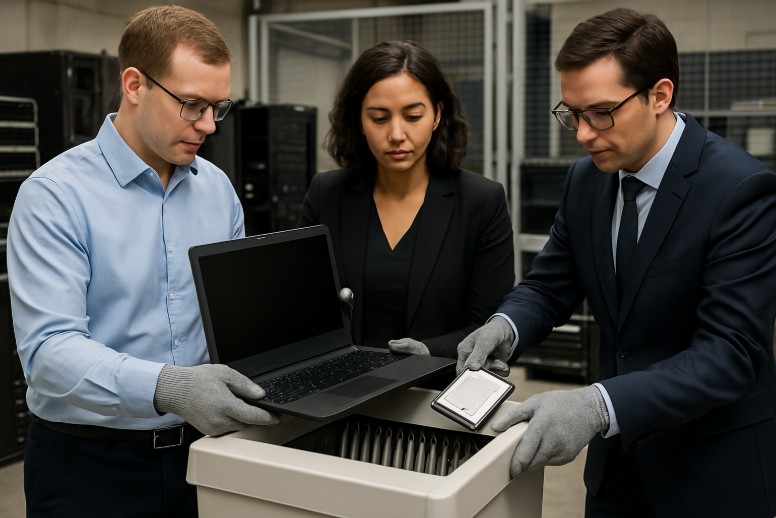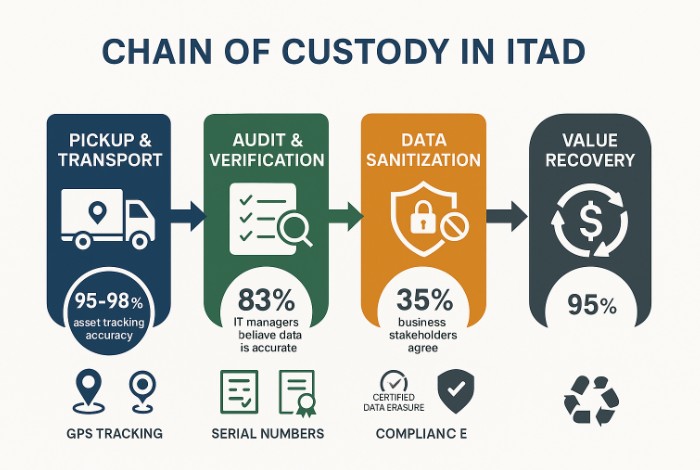In today’s digital landscape, data is one of the most valuable assets any business manages. From sensitive customer information and proprietary intellectual property to financial records and strategic plans, the sheer volume and criticality of data managed by organizations are constantly expanding. However, with this proliferation of data comes an escalating responsibility: the secure and permanent disposal of information when it reaches the end of its lifecycle.
Simply deleting files or reformatting storage devices isn’t enough. That’s where certified data destruction matters. This process is not just as a best practice, but a fundamental necessity for businesses seeking to safeguard their operations, reputation, and regulatory standing.
Certified data destruction, executed by accredited professionals, ensures data stored on hard disk drives (HDDs), solid-state drives (SSDs), magnetic tapes, and optical media is completely and permanently destroyed. It’s verifiable and backed by a formal certificate of destruction.
For OEM Source and our partners, certified data destruction offers a multitude of compelling benefits, extending far beyond mere compliance to encompass enhanced security, fortified brand reputation, and strengthened customer trust.
Ensuring Regulatory Compliance and Avoiding Costly Penalties
Enterprises today operate under an increasingly complex web of data privacy and protection regulations. Laws the General Data Protection Regulation (GDPR) in Europe, the Health Insurance Portability and Accountability Act (HIPAA) for healthcare information in the United States, the Gramm-Leach-Bliley Act (GLBA) for financial institutions, and various state-specific laws like the California Consumer Privacy Act (CCPA) impose strict requirements on how organizations collect, store, process, and—critically—dispose of sensitive data.
Non-compliance with these regulations isn’t just a risk—it’s a liability. Penalties can include severe financial fines, reputational damage, and legal liabilities that can cripple an enterprise. Certified data destruction services help organizations meet these rigorous compliance obligations.
Trusted providers follow recognized industry standards, such as those set by the National Association for Information Destruction (NAID), and provide a formal Certificate of Destruction upon completion of the service. This certificate serves as auditable proof that data has been permanently destroyed in a manner that meets or exceeds regulatory requirements—offering a crucial defense in the event of an audit or investigation.
Under GDPR, for instance, non-compliance can result in fines of up to 4% of annual global turnover or €20 million, whichever is greater—and the associated legal costs. This proactive approach to data end-of-life management is a cornerstone of a robust compliance strategy, demonstrating due diligence and a commitment to lawful data handling practices.
Maintaining a clear and documented audit trail for data destruction is increasingly becoming a standard expectation from regulators and business partners alike, making certified services an essential component of responsible corporate governance in the digital age.
Protecting Sensitive Information and Brand Reputation
In today’s data-driven economy, sensitive information is as valuable as currency—and just as vulnerable. A breach can have lasting consequences for an enterprise, extending far beyond immediate financial losses.
Sensitive data encompasses a wide range: customer personally identifiable information (PII), employee records, financial data, intellectual property, trade secrets, and strategic business plans. The unauthorized disclosure or theft of such data can lead to severe reputational damage—eroding the trust with customers, partners, and stakeholders. A tarnished brand reputation is incredibly difficult and costly to rebuild, often resulting in long-term customer attrition and a diminished market standing.
Certified data destruction helps protect against these risks. Unlike basic deletion or formatting—both of which may leave data recoverable—certified destruction ensures that all sensitive information on end-of-life IT equipment is completely and permanently eradicated. Methods like physical shredding, crushing, or degaussing ensure that the data is rendered entirely unreadable and unrecoverable, effectively eliminating the risk of it falling into the wrong hands.
By proactively implementing certified data destruction protocols, enterprises send a clear message about their commitment to data security and privacy. This commitment not only safeguards the company’s own valuable information assets but also demonstrates a respect for the confidentiality of customer and partner data.
In a competitive marketplace, a strong reputation for data security can be a significant differentiator, fostering customer loyalty and attracting new business. Conversely, a publicized data breach stemming from improper disposal of old equipment can lead to negative press, regulatory scrutiny, and a loss of competitive advantage. Therefore, investing in certified data destruction is a direct investment in protecting the brand’s integrity and the invaluable trust it has cultivated.
Preventing Data Breaches and Mitigating Cyber Threats
The landscape of cyber threats is constantly evolving. Attackers continue to develop new methods to infiltrate corporate networks and exfiltrate valuable data, and data breaches now represent one of the most significant risks to modern enterprises.
The cost of a breach can be staggering. Potential consequences include substantial financial losses from recovery costs, regulatory fines, and legal fees, as well as severe damage to operational continuity and customer trust. End-of-life IT assets, if not disposed of securely, can also become a critical vulnerability, providing an unintended backdoor for cybercriminals.
Even after decommissioning, residual data can persist on hard drives and other storage media. If these devices are improperly discarded, resold without adequate sanitization, or intercepted during transport, the data can be easily recovered and exploited.
Certified data destruction closes that security gap. Whether through physical destruction or certified data erasure that overwrites information to established standards, the result is the same: the data becomes unrecoverable.
Enterprises that follow guidelines outlined by the National Institute of Standards and Technology (NIST) ensure secure, irreversible destruction of sensitive data—such as login credentials, financial account details, confidential business strategies, or personal customer data.
Integrating certified data destruction into an enterprise’s overall cybersecurity strategy is therefore not just a reactive measure but a proactive defense. It significantly reduces the attack surface and strengthens the organization’s resilience against the pervasive threat of data breaches and cybercrime.
For OEM Source and our network of professionals, it underscores a commitment to a defense-in-depth security posture, where every potential vulnerability, including those associated with asset disposition, is meticulously managed.
Ensuring Customer Trust and Loyalty
In the contemporary business environment, customer trust isn’t optional—it’s foundational to long-term success. As customers become more aware of the value of their personal data, they are also becoming increasingly concerned about how enterprises collect, use, and protect it.
That’s why demonstrating strong data security practices—including how data is destroyed—plays a pivotal role in building and maintaining this trust. When someone shares their personal details, financial records, or private communications, they expect that it will be handled responsibly and protected from start to finish—even after they cease to be active clients or when their data is no longer needed for its original purpose.
Certified data destruction provides tangible evidence of an organization’s dedication to upholding these expectations. By transparently communicating data destruction policies and utilizing certified services, businesses can reassure their customers that their information will be permanently and securely disposed of, minimizing the risk of it ever being compromised.
This proactive stance on data privacy can significantly enhance customer confidence and foster a deeper sense of loyalty. Customers are more likely to remain with and advocate for companies that they perceive as trustworthy stewards of their data. Alternatively, incidents of data mishandling or breaches resulting from inadequate disposal practices can irrevocably damage customer trust, leading to churn, negative word-of-mouth, and a reluctance from potential new customers to engage.
For OEM Source, investing in certified data destruction is a direct investment in customer relationships. It reinforces the brand’s role as a trustworthy, ethical partner—something that’s increasingly important as trust becomes a top factor in customers’ purchasing decisions and their willingness to engage in long-term business relationships.
Supporting Environmental Responsibility and Sustainability
Beyond the critical aspects of data security and regulatory compliance, certified data destruction also plays an important role in supporting an enterprise’s commitment to environmental responsibility and sustainability.
As IT equipment lifecycles shorten, the volume of e-waste grows. Servers, computers, and hard drives often contain hazardous materials such as lead, mercury, cadmium, and brominated flame retardants. If sent to landfills, these toxins can leach into soil and water systems, causing pollution and long-term harm to ecosystems and human health.
Certified data destruction services—especially those offered by IT Asset Disposition (ITAD) services with like R2 certifications—often integrate responsible recycling and material reclamation into their processes. Once data has been securely and verifiably destroyed, the physical components of the storage media and associated hardware can be dismantled and processed responsibly. Components are recyclable, and valuable materials like precious metals, copper, aluminum, and plastics can be recovered and reintroduced into the manufacturing supply chain.
This supports circular economy goals while reducing the need for raw resource extraction and minimizing the environmental footprint associated with producing new electronics.
By partnering with certified data destruction providers who prioritize environmental stewardship, enterprises can ensure that old IT assets are both sanitized of all sensitive data and sustainably disposed of. This approach aligns with corporate social responsibility (CSR) goals and contributes to sustainability initiatives.
Documenting these responsible disposal practices—often facilitated by the ITAD provider—can also enhance environmental reporting and strengthen your brand with customers and stakeholders who value sustainability
How OEM Source Champions Secure and Certified Data Destruction
Enterprises seeking a reliable partner for managing the end-of-life of their IT assets, including the critical process of certified data destruction, can count on OEM Source for comprehensive and trustworthy solutions. With a deep understanding of the OEM technology lifecycle and a proven commitment to customer protection, OEM Source integrates certified data destruction into every IT Asset Disposition engagement.
We recognize that for our clients, the assurance of complete data eradication is non-negotiable. That’s why OEM Source partners with industry-leading, certified data destruction specialists who employ state-of-the-art techniques compliant with rigorous standards such as those set by NAID and NIST for media sanitization.
Whether you require on-site shredding for maximum security or secure off-site destruction at a certified facility, OEM Source tailors to your specific security protocols and compliance needs. The process is transparent, auditable, and aligned with your internal security protocols.
We ensure that every data-bearing device, from server hard drives and enterprise storage arrays to employee laptops and mobile devices, undergoes a meticulous destruction process. Upon completion, clients receive a Certificate of Destruction, providing auditable documentation necessary to demonstrate due diligence and satisfy regulatory requirements.
Beyond the destruction itself, our services encompass the full spectrum of ITAD, including secure logistics, inventory management, and environmentally responsible e-waste recycling. Every step ensures that your retirement assets are handled securely and sustainably from start to finish.
By choosing OEM Source, you’re partnering with a company dedicated to protecting your sensitive data, upholding our brand reputation, and ensuring compliance (see our certifications), all while supporting your environmental sustainability goals. We are committed to providing peace of mind through reliable, certified data destruction services that meet the highest industry standards.
Frequently Asked Questions (FAQs) about Certified Data Destruction for Enterprises
What is certified data destruction and why is it important for enterprises?
Certified data destruction is the process of permanently and irreversibly destroying data stored on various media like hard drives, SSDs, and tapes using methods that comply with recognized industry standards such as NAID AAA Certification. For enterprises, it’s essential to protect sensitive information, comply with data privacy regulations (like GDPR, HIPAA, FACTA, GLBA), prevent data breaches, safeguard brand reputation, and ensure customer trust. Most providers issue a Certificate of Destruction as proof of secure disposal.
Is simply erasing or reformatting hard drives sufficient for data destruction in an enterprise setting?
No. Erasing or reformatting drives is often insufficient for enterprise-level data security. Data can frequently be recovered from erased or reformatted media using specialized software and techniques. Physical destruction (e.g., shredding, crushing, degaussing) or certified data erasure methods that overwrite data multiple times to specific standards like NIST Special Publication 800-88 are necessary to ensure data is completely unrecoverable. These methods ensure the data is permanently unrecoverable.
What types of media and devices should be included in an enterprise data destruction program?
All IT assets and media that store sensitive enterprise data should be included. This includes:
- Server workstation HDDs/SSDs
- Backup tapes
- CDs/DVDs
- USB drives and memory cards
- Mobile phones and tablets,
- Obsolete or end-of-life electronic storage devices
What are the legal and regulatory requirements for data destruction that enterprises must consider?
Regulations vary by region and industry. Common examples include:
- HIPAA for healthcare data
- GDPR for personal data of EU residents
- GLBA for financial information
- FACTA for consumer credit information
Non-compliance can lead to severe financial penalties, legal action, and reputational damage. Consulting with legal counsel is advisable to understand all applicable regulations for your specific industry and operations.
What is a Certificate of Destruction, and why is it important for enterprises?
A Certificate of Destruction (CoD) is a formal document issued by a certified data destruction provider. It confirms that an enterprise’s data-bearing assets have been destroyed in accordance with specific standards and regulations. The CoD provides an auditable record for compliance purposes, demonstrating due diligence in protecting sensitive information and fulfilling legal obligations. It is a critical piece of documentation for internal controls and external audits.
How does certified data destruction contribute to an enterprise’s environmental sustainability goals?
Reputable certified data destruction providers, especially those with environmental certifications like R2, integrate environmentally responsible recycling practices into their services. After data is destroyed, the physical components of the devices are dismantled, and materials like metals and plastics are separated for recycling and reclamation. This reduces e-waste, conserves natural resources, and helps enterprises meet their corporate social responsibility (CSR) and sustainability objectives.
What should an enterprise look for when choosing a certified data destruction provider?
Look for providers with recognized certifications like NAID AAA, which involves regular, unannounced audits of security, employee screening, processes, and insurance.
Inquire about their specific destruction methods (shredding, degaussing, erasure standards), their process for handling e-waste and recycling, whether they offer on-site or off-site services, their chain-of-custody procedures, and their ability to provide detailed reporting and Certificates of Destruction and Recycling.
Ensure their services align with your enterprise’s specific compliance and security requirements. Consider exploring options like OEM Source’s ITAD services for a comprehensive solution.





